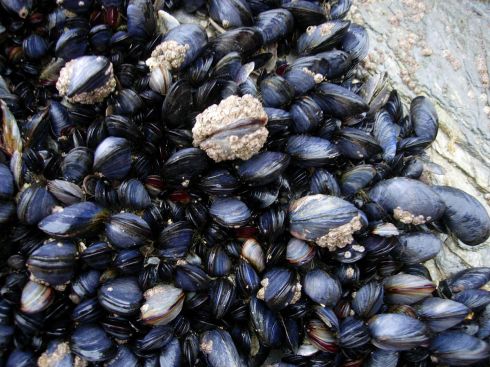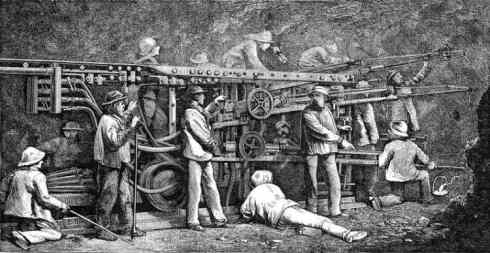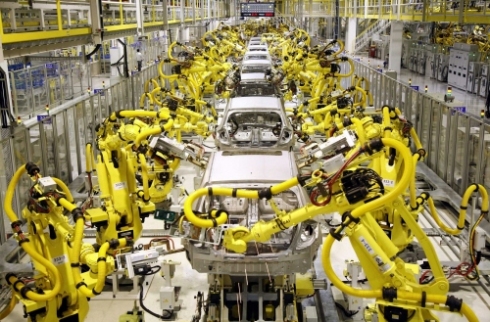You are currently browsing the tag archive for the ‘industrial’ tag.
Disturbing news from the world of workplace safety. Gillian Genser, a 59-year-old Canadian sculptor, has been suffering from worsening pain, splitting headaches, and nausea for nearly a decade and a half. She visited a range of specialized neurologists and endocrinologists, but none of them could pinpoint the nature of her malady which grew worse to the point that she was immobilized and suffered complete loss of hearing in one ear. She was unable to distinguish up from down, forgot the names and faces of people, she knew her whole life, and discovered herself wandering the streets for no reason shouting profanities. The doctors suspected heavy-metal poisoning, but Genser vehemently insisted that her materials were all natural.

If you are an artist yourself, you are probably shouting—but this is clearly heavy metal poisoning! And you are right: Genser finally was diagnosed with acute arsenic and lead poisoning after one of her physicians insisted on a blood test. Yet Genser was not a painter (like me, sigh) nor did she cast in metals or use exotic glazes and stains. Her only materials were silver and mussel shells which she polished agonizingly by hand.

She obtained the blue mussels from a market in Toronto’s Chinatown and ate the mollusks with friends. She then used the shells for her larger than life anatomical sculpture of Adam, the mythical first human from the Abrahamic faiths. Sadly, whoever was providing the shellfish was obtaining them from water which was heavily polluted. Mussels store metals in their shells, and Genser’s polishing, sanding, and shaping freed the trapped pollutants into dust which she inhaled (although eating 3 meals a week of mussel flesh probably didn’t help either). The story is even more troubling when one reflects that blue mussels are an Atlantic shellfish and Toronto is at least 800 kilometers (500 miles) from the waves.

Hey! Has anyone noticed that Toronto is apparently right next to New York State? Where were these mussels from anyway?
The moral here in not “don’t be an artist” or “don’t eat mussels” (although, come to think of it, those are extremely plausible lessons). Instead everyone needs to be careful in the modern world to watch out for hazardous materials which proliferate in unexpected ways from novel sources. Of course, this is hardly a soothing message since most of us are not chemists (much less endocrinologists) and it looks like even those experts can’t always see where problems are coming from. Maybe the real lesson is that humankind’s vast numbers and sophisticated industrial society are fundamentally inimical to the web of life which sustains us. Actually, that is an even less comfortable message…but, well, I am not a politician here to sooth you with lies. We have learned how to protect ourselves from the natural world. Now we are going to have to learn (quickly) how to protect the natural world from ourselves.

Anyway, let’s take a look at the sculpture that caused such suffering for Genser (see the photos above from the artist). It looks like the metal-poisoning started to fundamentally work its way into the sculpture itself—in terms of conception, execution, AND material (obviously). Yet there is something oddly appropriate about the subject matter (Adam’s choices, after all, are a metaphor for humankind’s great metamorphosis from hunter-gathering beings to civilization-building farmers and crafters). The dark armless statue with the alien face and the black glistening muscles and nacreous organs, seems to be a sort of manifestation of heavy metal poisoning. The whole 15 year project has inadvertently become a performance piece about the pain of the world (just think of those poor mussels which can’t even move to escape their poisoned home waters). I hope that the short-lived media burst helps Genser’s career, but I also hope she switches media as soon as possible. While we are making wishes, let’s express some really heartfelt aspirations to be better stewards of the oceans. They are the cradle of life…yet they are being sadly abused.
My first job when I left college was working as an assistant curator at the Smithsonian’s National Museum of American History—“the nation’s attic” where great hoards of objects from our collective past have been (and continue to be) carefully squirreled away for the edification of future generations. A miniscule percentage of the museum’s collection is on display and the rest gathers dust in enormous WWII era aircraft hangers outside Washington DC where all sorts of jackhammers, graphite urns, failed rocket cars, threshing machines, whalebone bustles, (and everything else) are stored.

I honestly couldn’t find any photo of a vintage machine that looked as scary as any of the real ones I saw…
On my first trip to the storage facility in Suitland, I eagerly ran up to the nearest Quonset hut to peek inside. The giant building was filled with pointy overly complicated machines which did not make any sense to the untrained eye. One typical device had been hauled outside to be cleaned. Looming in the sunlight, it looked like an extra from a Steven King movie. It was about 8 feet tall and was made of gray steel with big dangerous foot pedals and alarming fly wheels. A person operating the monstrosity would lean into a whirling maw of metal gouges, hooks, and razor sharp metal spikes. Since it dated back to the end of the nineteenth century, there were no safety features: a moment of inattention would cause the machine’s operator to lose various fingers, hands, or feet. I was transfixed—what amazing purpose did this hellish device serve? The senior curator and I shuffled through the index cards till we found its acquisition/accession code: it was a machine from a long defunct factory in Waterbury which was designed to make tiny metal buckles!
Whenever I lament the state of the contemporary world economy, I think back to that hulking buckle-maker and I imagine what it would be like to work on it ten hours a day (pretty much like dancing a complicated quadrille with a demon). Thank goodness that horrible…thing… is in a museum and my livelihood does not involve years spent slaving over it in fear and tedium! Today, automation becomes more and more prevalent and the majority of the world’s goods are being made by fewer and fewer people. Industrial jobs are being outsourced to poor workers in the developing world, but even in China, Bangladesh, and the world’s worst sweatshops, the excesses of the industrial revolution are gradually being tamed.
I am bringing this up because I want to look forward into the economic future. Even today, we could work 15 hours a week and have the same standard of living, but we don’t because, well… nobody knows. Your pointless job of ordering widgets, looking at meaningless spreadsheets, and pushing awful HR papers around will be gone in 50 years and belong in a museum’s never-looked-at storage room (along with that gougetastic buckle-maker of yesteryear). But what stupid thing will we be doing instead?
Yesterday Ferrebeekeeper described the Luddite movement, an anti-technology workers’ revolt which occurred near the beginning of the Industrial Revolution. The revolt centered on the idea that labor-saving machines destroy jobs, a concept which economists decry as the “Luddite fallacy.” Most Neoclassical economists believe that, even if machines cause job losses in certain industries, such losses are more than offset by the attendant fall in prices for consumers. The history of the world since the beginning of the industrial revolution has borne this idea out, as more and more goods have become available to wider and wider markets. The history of first world nations reflects a sort of anti-Luddite narrative: farmers are not needed to plough the lands because of greater agricultural productivity so they go to work in factories. Factories then become more productive thanks to machines and cheap competition so the factory workers become tertiary sector employees. The tertiary sector consists of service jobs where employees do not necessarily make or produce anything tangible but instead offer support, experience, or knowledge—for example nurses, lawyers, waste-disposal professionals, casino employees, courtesans, financiers and such like (some economists posit that there is a quaternary sector of scientists, professors, computer geniuses, artists, and bloggers—the creative sector—but we needn’t get into that here).
Since the dawn of the Industrial era, this progression has worked admirably for creating economic progress. And, during that time, machines have been constantly improving. Whereas the horseless carriage once put horses, hostlers, and livery stables out of work but provided automakers with jobs, then robot arms and mechanized welding units came along to supplant those auto-workers. The displaced autoworkers all had to go out and become radiologists, actuaries, sex-workers, and restaurateurs. Now, however, machines are becoming sophisticated enough to invade the tertiary sector. Subtle computer programs are proving superior to trained (overworked) radiologists at finding the tiniest nascent tumors. Accountants are being replaced by Turbo-tax and Quickbooks. Weird Japanese scientists have built robots which…um make sushi and pour drinks. It seems like this trend is going to gobble up a great many service jobs in the near future from all strata of society.
A world where machines are able to replace white-collar workers would mean the hollowing out of the middle class. The international corporations and plutocrats making software, robots, and automated factories would become extravagantly rich while the rest of would have to struggle to find niches the machines haven’t taken over. A huge economic slump would grip the developed world–as average consumers became unable to buy the goods turned out by those factories. Hmm, that seems awfully familiar.
So are the Luddites finally correct? Should we go out and smash our computers and Roombas? Well… it isn’t like we can stop what we are doing. To move forward in science and manufacturing we are going to need better thinking machines. At some point these machines will be better at thinking then we are…and they will also be better than us at making machines. That point will be the technological singularity and it seems that we are on that path, unable to turn back. Perhaps we will end up with a race of omniscient omnipotent servants (yay!). Perhaps we will combine with machines and become mighty cyborgs. Perhaps we will end up as housepets or as a mountain of skulls the robots walk on and laugh at. I don’t know. Nobody does. Yikes! How did this essay about a nineteenth century protest movement take us to this destination?
In the mean time, it would be useful if people would talk more about what we want from our technology and how we can get there. The fact that having better machines is currently splitting society into some dysfunctional Edwardian plutocracy is disquieting. It means we are not thinking hard enough or using our imaginations. We should start doing so now…while we are still allowed to!
Ned Ludd was a person with severe developmental problems back in the 18th century, when society lacked effective ways of assisting people with disabilities. In the cruel parlance of the time he was a “half-wit”. Supposedly, Ned worked as a weaver in Anstey (an English village which was the gateway to the ancient Charnwood forest). In 1779, something went wrong—either Ned misunderstood a confusing directive, or he was whipped for inefficiency, or the taunts of the villagers drove him to rage. He picked up a hammer and smashed two brand new stocking frames (a sort of mechanical knitting machine used to quickly weave textiles). Then he fled off into the wilderness where he lived as a freeman. Some say that in the primal forests he learned to become a king.
Ned is important not because of his life (indeed it seems likely that he was not real—or, at best, he was just barely real) but because he was mythicized into a larger-than-life figure around whom the Luddite movement coalesced. This diffuse social rebellion had some roots in the austere and straightened times of the Napoleonic war but it was mostly a direct response to the first sweeping changes wrought by the Industrial revolution. Skilled weavers and textile artisans were aggrieved that machines operated by unskilled workpeople could easily produce much more fabric than trained artisans using traditional methods. The unskilled workpeople were angry at being underpaid and mistreated in the harsh dangerous early factories. This anger was combined with widespread popular discontent about the privations of war and the rapacity of the elite. Free companies of rebels met and drilled at night in Sherwood Forest or on vacant moorland. Anonymous malefactors smashed the new machines. Mills burnt down and factory owners were threatened. It was whispered that it was all the work of “King Ludd” whose rough signatures appeared on broadsheets and threatening letters.
The first wave of Luddite Rebellion broke out in 1811 centered in Nottingham and the surrounding areas. It is interesting that the same region which came up with Robin Hood, the hero-thief of folklore, also was responsible for remaking Ned Ludd from a lumpen outsider into a bellicose king of anti-technology. Disgruntled (male) artisans marched in women’s clothes and called themselves “Ned Ludd’s wives”. Circulars were addressed from the “king’s” office deep in Sherwood forest.
The original teasing tone quickly vanished as Luddite uprisings broke out across Northern England in the subsequent months and years until British regulars were sent in to quash them. For a brief period, there were more redcoats putting down Luddite insurrections in England than there were fighting Napoleon on the Iberian Peninsula. Professional soldiers made short work of the rebels and Parliament hastily enacted a series of laws which made “machine-breaking” a capital crime. A number of Luddites were executed and others were transported to Australia.
Ned Ludd escaped these reprisals by being from a different era (and fictional). “Luddite” has now become a preferred label for all people who eschew technology. The half-wit King Ned still lives on in the imagination of people who have lost their jobs to the march of progress and in the nightmares of technophiles and economists. Indeed one of the great constructs/truisms of economics is the Luddite fallacy—which holds that labor saving devices increase unemployment. Neoclassical economists (who named the concept) assert that it is a fallacy because labor saving devices decrease the cost of goods—allowing more consumers to obtain them. However there are some who believe this has only been the case so far because the machines have not become sophisticated enough. Once a certain threshold of technology is passed thinking machines might replace many skilled positions as well as unskilled ones. This simultaneously awesome and horrifying concept will be our theme tomorrow.
The Aztec goddess of death was Mictecacihuatl. According to myth she was once alive countless ages ago—a member of an ancient pre-human race of beings who lived when the world was new. But her time in the living world was short since she was sacrificed to the underworld as an infant. After her death, she grew to adulthood as a magical skeleton deity of immense power. She has lived through countless cycles as a goddess of bones and death and the dead, rising ultimately to become queen of the underworld. One of her foremost duties as the ruler of the dark realm is to guard the skeletal remains of extinct earlier races. In the past Mictecacihuatl failed in her duties and Xolotl, god of sickness and lightning, stole one of the sacred corpses of those who lived long before–which the gods of the sky then fashioned into living modern human beings. Now Mictecacihuatl must also guard the bones of dead humans, for she believes that our remains could be used by capricious sky gods to build an even more ruthless group of alien new beings.
Wow! Aztec religion really does not hold back on the bizarre, the macabre, and the unfathomable–but what does all this have to do with flowers of the underworld? Well, it turns out that Mictecacihuatl has a weakness for flowers. The brilliant yellow cempasúchil–today known as flor de muertos–was sacred to her, and Aztecs believed the smell of the blossoms could wake the souls of the dead and bring them temporarily back to earth for the great autumn festival in their honor. Huge altars laden with food were erected and festooned with the flowers. It was one of the most important traditions of the Aztecs, and even after the Spanish conquest, the tradition continued. Despite the long efforts of the Spanish church to eradicate the festival of the dead it lingers to this day (though now as a church holiday), celebrated on November 2nd as Dia De los Muertos, or “day of the dead”. The graveyards are filled with yellow cempasúchils which for a time reign supreme among flower markets throughout Mexico. Along with candy, jaunty toy skeletons, and liquor, the flor de muertosare an inextricable part of this festive time.
And what sort of flower is the cempasúchil, which has so much power over the spirits of the dead and Mictecacihuatl, goddess of the underworld herself? The botanists call it Tagetes erecta, one of about 75 members of the marigold family– those omnipresent orange and yellow flowers known to every American schoolchild! The English name for the flower of the dead is the Mexican marigold. The plants grow wild in a belt running across central Mexico.
In the preconquest Meso-American world, the flowers were valuable and were used as a dye, an antibacterial, a foodstuff, and a skin-wash/cosmetic. Additionally, when planted with maize crops, marigolds in general (and the cempasúchil specifically) prevent nematode damage. Even today, there are industrial uses for the cempasúchils and they are also used as ingredients in perfumes, salads, and as food colorings. In agriculture, extracts of the plant are added to chicken feed (to give the yolks their yellow color) and are used to enhance the color of shrimp and other edible crustaceans. The other fascinating plants we have examined this week—the asphodel, the devil’s hand (another plant sacred to the Aztecs!), and the deadly aconites are not grown or produced in any quantities remotely approaching the enormous annual cempasúchil harvest. Cempasúchils have benefited from their association with the dead–they are a huge success. The little yellow Mexican marigold is one of the most popular flowers in the world.















